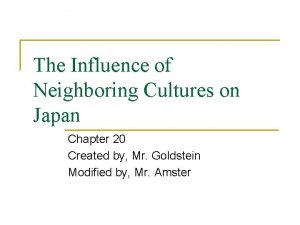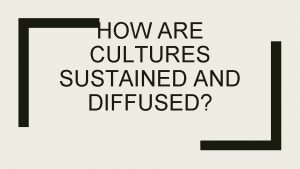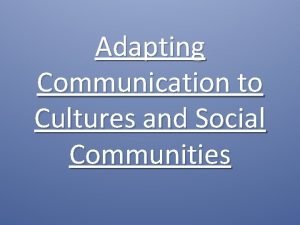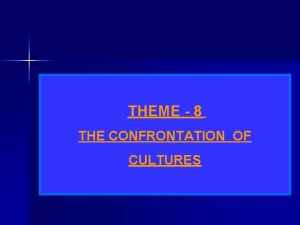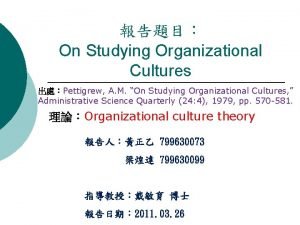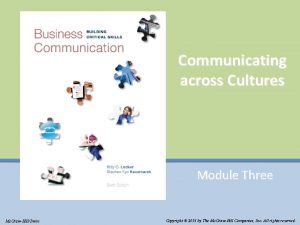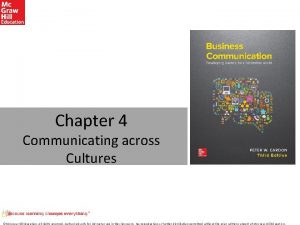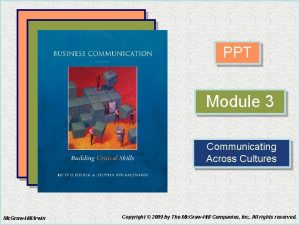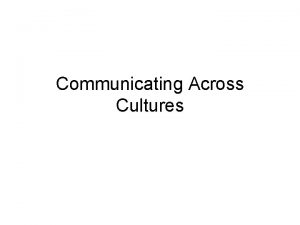Chapter 4 Communicating Across Cultures 4 1 Copyright

























































- Slides: 57

Chapter 4: Communicating Across Cultures 4 -1 Copyright © 2017 Pearson Education, Inc. Ninth Edition

Chapter Learning Goals 1. To recognize the cultural variables in the communication process and what factors can cause noise in that process 2. To appreciate the cultural variables that affect communication for both the sender and the listener 3. To be aware of the impact of IT on crossborder communications 4. To learn how to manage cross-cultural business communications successfully 4 -2 Copyright © 2017 Pearson Education, Inc.

Opening Profile: The Impact of Social Media on Global Business Managers in international businesses are grappling with the question of how to benefit from social media networks Social media are potential sources of rich information outside the normal chain of communication Measuring the effectiveness of each source of social media is a challenge 4 -3 Copyright © 2017 Pearson Education, Inc.

The Communication Process 4 -4 Copyright © 2017 Pearson Education, Inc.

Chapter Learning Goals To recognize the cultural variables in the communication process and what factors can cause noise in that process 4 -5 Copyright © 2017 Pearson Education, Inc.

Definition of Communication is the process of sharing meaning by transmitting messages through media such as words, behavior, or material artifacts. 6 Copyright © 2014 Pearson Education, Inc. publishing as Prentice Hall

Cultural Noise in International Communication Behavior German: “What can be done to make sure this project is completed on time? ” Attribution German: “I am giving him some responsibility. ” Indian: “He is the boss, why is he asking me? ” Indian: “I don’t know. What do you suggest? ” German: “Can’t he take responsibility? ” Indian: “I asked him for instructions. ” 4 -7 Copyright © 2017 Pearson Education, Inc.

When a member of one culture sends a message to a member of another culture, intercultural communication occurs. The message contains the meaning intended by the encoder, but the decoder’s culture ends up becoming part of the meaning as he/she interprets the message. Attribution is the process in which people look for an explanation of another person’s behavior. When someone does not understand another, he/she usually blames the confusion on the other’s “stupidity, deceit, or craziness. ” 8 Copyright © 2014 Pearson Education, Inc. publishing as Prentice Hall This slide illustrates miscommunication and cultural

The Culture-Communication Link: Trust in Communication The meaning of trust and how it is communicated vary across societies When there is trust between parties, implicit understanding arises within communications Guidelines: Create a clear and calculated basis for natural benefit Improve predictability Develop mutual bonding 4 -9 Copyright © 2017 Pearson Education, Inc.

The Culture-Communication Link: The Globe Project High Performance • Present objective information Orientation: directly and specifically United States Low Assertivenes • Two-way discourse and s: friendly relationship Sweden High Human Orientation: • Avoid conflict, be supportive Ireland 4 -10 Copyright © 2017 Pearson Education, Inc.

Chapter Learning Goals To appreciate the cultural variables that affect communication for both the sender and the listener 4 -11 Copyright © 2017 Pearson Education, Inc.

India 4 -12 Copyright © 2017 Pearson Education, Inc.

Under the Lens: India Communicating in India—Language, Culture, Customs, and Etiquette • The different states of India have different official languages • The central government named Hindi as the official language of India • Indians are conscious of social order and status • People define themselves by the groups to which they belong • Indian names vary based on religion, social class, and region of the country 4 -13 Copyright © 2017 Pearson Education, Inc.

Cultural Variables in Communication 4 -14 Attitudes Stereotyping Social Organization United Auto Workers (UAW) Thought Patterns The meaning of double lines Copyright © 2017 Pearson Education, Inc.

Attitudes We all know that our attitudes underlie 15 the way we behave and communicate and the way we interpret messages from others. Ethnocentric attitudes are a particular source of noise in crosscultural communication. In the incident described in Exhibit 4 -2, both the Indian and the German are clearly attempting to interpret and convey meaning based on their own experiences of that kind of transaction. The German is probably guilty of stereotyping the Indian employee by quickly jumping to the conclusion that he is unwilling to Copyright © 2014 Pearson Education, Inc. publishing take. Hallresponsibility for the task and the scheduling. as Prentice

stereotyping This problem, stereotyping, occurs when a person assumes that every member of a society or subculture has the same characteristics or traits. Stereotyping is a common cause of misunderstanding in intercultural communication. It is an arbitrary, lazy, and often destructive way to find out about people. Astute managers are aware of the dangers of cultural stereotyping and deal with each person as an individual with whom they may form a unique relationship. 16 Copyright © 2014 Pearson Education, Inc. publishing as Prentice Hall

Social organization Our perceptions can be influenced by 17 differences in values, approach, or priorities relative to the kind of social organizations to which we belong. These organizations may be based on one’s nation, tribe, or religious sect, or they may consist of the members of a certain profession. Examples of such organizations include the Academy of Management or the United Auto Workers (UAW). 26 Copyright © 2014 Pearson Education, Inc. publishing as Prentice Hall

Thought Patterns The logical progression of reasoning varies widely around the world and greatly affects the communication process. Managers cannot assume that others use the same reasoning processes, as illustrated by the experience of a Canadian expatriate in Thailand, related in a book by Harris and Moran: 18 Copyright © 2014 Pearson Education, Inc. publishing as Prentice Hall

Thought Patterns While in Thailand a Canadian expatriate’s car was hit 19 by a Thai motorist who had crossed over the double line while passing another vehicle. After failing to establish that the fault lay with the Thai driver, the Canadian flagged down a policeman. After several minutes of seemingly futile discussion, the Canadian pointed out the double line in the middle of the road and asked the policeman directly, “What do these lines signify? ” The policeman replied, “They indicate the center of the road and are there so I can establish just how far the accident is from that point. ” The Canadian was silent. It had never occurred to him that the double Copyright © 2014 Pearson Education, Inc. publishing line Hall might not mean “no passing allowed. ” as Prentice

Thought Patterns In the Exhibit 4 -2 scenario, perhaps the German did not realize that the Indian employee had a different rationale for his time estimate for the job. Because the Indian was not used to having to estimate schedules, he just took a guess, which he felt he had been forced to do. 20 Copyright © 2014 Pearson Education, Inc. publishing as Prentice Hall

Roles Societies differ considerably in their perceptions of a manager’s role. Much of the difference is attributable to their perceptions of who should make the decisions and who has responsibility for what. In the Exhibit 4 -2 example, the German assumes that his role as manager is to delegate responsibility, to foster autonomy, and to practice participative management. He prescribes the role of the employee without any consideration of whether the employee will understand that 21 Copyright © 2014 Pearson Education, Inc. publishing as Prentice Hall

Roles The Indian’s frame of reference leads him to think that the manager is the boss and should give the order about when to have the job completed. He interprets the German’s behavior as breaking that frame of reference, and therefore he feels that the boss is “stupid and incompetent” for giving him the wrong order and for not recognizing and appreciating his accomplishments. The manager should have considered what behaviors Indian workers would expect of him and then either should have played that role or discussed the situation carefully, in a training mode. 22 Copyright © 2014 Pearson Education, Inc. publishing as Prentice Hall

These cultural variables (and those on the next slide) can affect communication via a person’s perceptions. The effects of these variables are interdependent and inseparable. 23 Copyright © 2014 Pearson Education, Inc. publishing as Prentice Hall

Cultural Variables in Communication 4 -24 Roles Decision making and responsibility Language “come out of the grave with Pepsi” When “yes” doesn’t mean “yes” Copyright © 2017 Pearson Education, Inc.

Roles When two people do not share a common language, 25 communication problems arise. Even in countries that share the same language, problems can arise from the subtleties and nuances inherent in language. Because of increasing diversity, managers often have to deal with workforces that speak a variety of languages— even within a single country. Translation can be problematic as well. Pepsi provides one example of translation problems. As another example, when many Asians say “yes, ” it often means only that they have heard you and are too polite to disagree. Sometimes how something is said is more important than what is Copyright © 2014 Pearson Education, Inc. publishing said. Hall as Prentice

Language Spoken or written language, of course, is a frequent cause of miscommunication, stemming from a person’s inability to speak the local language, a poor or tooliteral translation, a speaker’s failure to explain idioms, or a person missing the meaning conveyed through body language or certain symbols. Even among countries that share the same language, problems can arise from the subtleties and nuances inherent in the use of the language 26 Copyright © 2014 Pearson Education, Inc. publishing as Prentice Hall

Language As noted by George Bernard Shaw: “Britain and America are two nations separated by a common language. ” This problem can exist even within the same country among different subcultures or subgroups. Many international executives tell stories about lost business deals or lost sales because of communication blunders: 27 Copyright © 2014 Pearson Education, Inc. publishing as Prentice Hall

Language When Pepsi Cola’s slogan “Come Alive with Pepsi” was introduced in Germany, the company learned that the literal German translation of “come alive” is “come out of the grave. ” A U. S. airline found a lack of demand for its “rendezvous lounges” on its Boeing 747 s. They later learned that “rendezvous” in Portuguese refers to a room that is rented for prostitution 28 Copyright © 2014 Pearson Education, Inc. publishing as Prentice Hall

Language More than just conveying objective information, language also conveys cultural and social understandings from one generation to the next. Examples of how language reflects what is important in a society include the 6, 000 different Arabic words used to describe camels and their parts 29 Copyright © 2014 Pearson Education, Inc. publishing as Prentice Hall

Cultural Variables in Communication Nonverbal Communication “A picture is worth a thousand words. ” Subtle messages account for between 65 to 93 percent of interpreted communication Minor variations in body language, speech rhythms, and punctuality often cause mistrust and misperception of the situation among cross-cultural parties 4 -30 Copyright © 2017 Pearson Education, Inc.

The Media for Nonverbal Communication Kinesic behavior—communication through body movements Proxemics—the influence of proximity and space on communication—both personal space and office space or layout High-contact cultures: prefer to stand close and to experience a “close” sensory involvement Low-contact cultures: have a “distant” style of body language Paralanguage—how than the content 4 -31 Copyright © 2017 Pearson Education, Inc. something is said rather

Under the Lens: Communicating Italian Style Italians use the most body language when communicating Italians make about 250 gestures when talking and doing other things such as conversing on the cell phone Gestures are culture-specific, varying according to the area in Italy Italians tend to be gregarious, loud, and interrupt one another 4 -32 Copyright © 2017 Pearson Education, Inc

Under the Lens: How Feng Shui Affects Business Directing “Qi” for positive results Experts read energy patterns and face buildings in a particular direction, design gardens in a positive way, and use Qi to influence an individual’s life Trump properties, Michael Rudder Fourth floor in China, Japan, Korea 4 -33 Copyright © 2017 Pearson Education, Inc.

The Media for Nonverbal Communication Object language/material culture—the way we communicate through material artifacts Monochronic cultures (Switzerland, Germany, United States): time is experienced in a linear way Polychronic cultures (Latin Americans, Arabs): tolerate many things happening simultaneously and may focus on several things at once 4 -34 Copyright © 2017 Pearson Education, Inc.

Forms of Nonverbal Communication Facial expressions; eye contact Body posture; interpersonal distance Body contact Clothing cosmetics; hairstyles Para language 4 -35 Copyright © 2017 Pearson Education, Inc.

Object Language/Material Culture Open displays of wealth Japanese ‘meishi’ or business cards Mexico: appreciating the architecture and family photos 4 -20 Copyright © 2017 Pearson Education, Inc.

Context 4 -37 High Context Cultures Low Context Cultures Feelings and thoughts are not explicitly expressed; key information is embedded in the context Personal and business relationships are more compartmentalized, communication has to be more explicit. Feelings and thoughts are expressed in words Copyright © 2017 Pearson Education, Inc.

Cultural Context and Its Effect on Communication 4 -38 Copyright © 2017 Pearson Education, Inc.

Management In Action: Oriental Poker Face “Oriental poker face” and “idiotic Asian smile” American mask of confidence 4 -39 Copyright © 2017 Pearson Education, Inc.

Comparative Management in Focus: Communicating with Arabs are quick to “sound off” Communication is built on friendship, honor, hospitality, religion Arabs are high-contact communicators Time is the key in communication process: deadlines are considered rude and pushy 4 -40 Copyright © 2017 Pearson Education, Inc.

4 -41 Copyright © 2017 Pearson Education, Inc

4 -42 Copyright © 20174 Pearson Education,

Communication Channels 4 -43 Copyright © 2017 Pearson Education, Inc.

Information Systems In centralized organizational structures as in South America, most information originates from top managers In the US information flows from the staff to managers Japan: ringi system High context cultures: information spreads rapidly and freely 4 -28 Copyright © 2017 Pearson Education, Inc.

Informal Sources of Information Employees drinking together Communication based on long-term relationships “Public self” vs. “Private self” 4 -29 Copyright © 2017 Pearson Education, Inc.

Speed of Information Americans expect to give and receive information very quickly and clearly French use slower message channels of deep relationships, culture, mediators 4 -30 Copyright © 2017 Pearson Education, Inc.

Japanese “Ningensei” vs. US Adversial Style 1. Indirect verbal and non -verbal communication; non-confrontational 1. Direct, confrontational communication accepted 2. Relationship communication; ambiguous 2. Task communication, to -the-point 3. Individualistic 4. Favors “odd” reason 3. 4. 4 -31 Group orientation Softer, sympathetic Copyright © 2017 Pearson Education, Inc.

Chapter Learning Goals To be aware of the impact of IT on cross-border communications 4 -48 Copyright © 2017 Pearson Education, Inc.

Information Technology: Going Global and Acting Local Global reach does not necessarily mean global business The Web is interpersonal, but may require greater cultural sensitivity Global online strategy must also be multi -local 4 -49 Copyright © 2017 Pearson Education, Inc.

Developing Cultural Sensitivity • Read a map: Familiarize yourself with the local geography to avoid making insulting mistakes • Dress up: In some countries, casual dress is a sign of disrespect • Talk small: Talking about wealth, power, or status—corporate or personal—can create resentment • No slang: Even casual profanity is unacceptable • 4 -34 Slow down Americans talk fast, eat fast, move Copyright © 2017 Pearson Inc. Many cultures do not fast, Education, live fast.

Developing Cultural Sensitivity Continued Listen as much as you talk: Ask people you’re visiting about themselves and their way of life Speak lower and slower: A loud voice is often perceived as bragging Religious restraint: In many countries, religion is not a subject for public discussion Political restraint: Steer clear of this If someone is attacking U. S. policies, agree to disagree 4 -51 Copyright © 2017 Pearson Education, Inc.

Chapter Learning Goals To learn how to manage crosscultural business communications successfully 4 -52 Copyright © 2017 Pearson Education, Inc.

Managing Cross-Cultural Communication Develop cultural sensitivity Anticipate the meaning the receiver will get Careful encoding Use words, pictures, and gestures Avoid slang, idioms, regional sayings Selective Transmission Build relationships, face-to-face if possible Careful decoding of feedback Get feedback from multiple parties Improve listening and observation skills Follow-up actions 4 -53 Copyright © 2017 Pearson Education, Inc.

Facilitating Intercultural Communication 4 -54 Openness • Open mindedness, tolerance for ambiguity, and extrovertedness Resilience • Having an internal locus of control, persistence, a tolerance for ambiguity, and resourcefulness Copyright © 2017 Pearson Education, Inc.

There is a connection between a person’s personality 55 traits and the ability to adapt to the host-country’s environment—including the ability to communicate within that environment. Two key personality traits are openness and resilience. Openness includes traits such as tolerance for ambiguity, extrovertedness, and open-mindedness. Resilience includes having an internal locus of control, persistence, tolerance for ambiguity, and resourcefulness. These factors, combined with the person’s cultural and racial identity and level of preparedness for change, Copyright © 2014 Pearson Education, Inc. publishing comprise that person’s potential for adaptation. as Prentice Hall

Conclusion Cultural sensitivity Awareness of potential sources of cultural noise Culture is the foundation of communication High-context vs. low context Careful encoding and selective transmission Cultural localization on the Internet 4 -39 Copyright © 2017 Pearson Education, Inc.

All rights reserved. No part of this publication may be reproduced, stored in a retrieval system, or transmitted, in any form or by any means, electronic, mechanical, photocopying, recording, or otherwise, without the prior written permission of the publisher. Printed in the United States of America. Copyright © 2017 Pearson Education, Inc. 57
 Communicating across cultures - ppt
Communicating across cultures - ppt Organizational cultures often reflect ________.
Organizational cultures often reflect ________. Communicating vs non communicating hydrocele
Communicating vs non communicating hydrocele Recreational activities across cultures and genders
Recreational activities across cultures and genders Body language across cultures respuestas
Body language across cultures respuestas Motivation across cultures
Motivation across cultures Motivation across cultures
Motivation across cultures Motivation across cultures
Motivation across cultures Communicating across generational differences
Communicating across generational differences Chapter 20:2 obtaining and handling cultures
Chapter 20:2 obtaining and handling cultures Chapter 5 a clash of cultures
Chapter 5 a clash of cultures What impact did nearness to the sea have on greece
What impact did nearness to the sea have on greece Chapter 13 section 1 cultures clash on the prairie
Chapter 13 section 1 cultures clash on the prairie The collision of cultures chapter 1
The collision of cultures chapter 1 What are the golden rules of human relations
What are the golden rules of human relations Chapter 6 lesson 3 communicating effectively answer key
Chapter 6 lesson 3 communicating effectively answer key Sub cultures
Sub cultures Which cultures believe in reincarnation
Which cultures believe in reincarnation What is sociology perspective
What is sociology perspective In what ways did neighboring cultures influence japan?
In what ways did neighboring cultures influence japan? Religions that believe in reincarnation
Religions that believe in reincarnation Which cultures believe in reincarnation
Which cultures believe in reincarnation Religion
Religion Small cultures
Small cultures Taste different cultures
Taste different cultures Types of cultures
Types of cultures Individualistic culture definition
Individualistic culture definition Collectivistic cultures
Collectivistic cultures Which cultures believe in reincarnation
Which cultures believe in reincarnation All cultures undergo
All cultures undergo How many cultures are there
How many cultures are there How are local cultures sustained
How are local cultures sustained High-context cultures emphasize nonverbal messages.
High-context cultures emphasize nonverbal messages. Words from many cultures weslandia answers
Words from many cultures weslandia answers Bacterial growth
Bacterial growth Pengertian transmisi budaya
Pengertian transmisi budaya Indulgence vs restraint india
Indulgence vs restraint india Georgia's prehistoric cultures chart
Georgia's prehistoric cultures chart Guided reading activity the human world
Guided reading activity the human world Social communities include a number of cultures.
Social communities include a number of cultures. Southeastern and gulf cultures
Southeastern and gulf cultures Konsep melting pot
Konsep melting pot Pour plate method vs spread plate method
Pour plate method vs spread plate method Cultures and organizations software of the mind
Cultures and organizations software of the mind Cesar chavez adjectives
Cesar chavez adjectives Spoken poetry about cultural relativism
Spoken poetry about cultural relativism Knorr cetina epistemic cultures
Knorr cetina epistemic cultures Confrontation of cultures
Confrontation of cultures Literacy shed zahra
Literacy shed zahra Tandem language
Tandem language Schein’s three levels of culture
Schein’s three levels of culture The globe framework for assessing cultures
The globe framework for assessing cultures Examples of mass culture
Examples of mass culture The stone ages and early cultures
The stone ages and early cultures What happens when different cultures meet
What happens when different cultures meet What is communication without words
What is communication without words Communicating classes markov chain
Communicating classes markov chain Communicating hydrocephalus
Communicating hydrocephalus



















